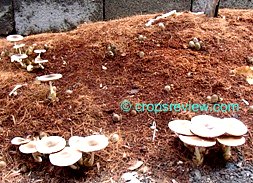Edible mushrooms, those wonderful saprophytic fungi, can be produced within the backyard at the same time that household wastes, sweepings, and other biodegradable materials are deliberately converted into compost through vermicomposting.
Vermicomposting is the process of producing organic soil supplement, called vermicompost, through the use of earthworms like the African night crawler or wriggler (Eudrilus eugeniae).
This technology was popularized in the Philippines by Dr. Rafael Guerrero III.
Normally, edible mushrooms are hunted during the rainy season.
We used to do this, usually from June to August, in our “playground” that is bounded to the west by the Silway River in General Santos City.

The place was then an agricultural farm with mix-planted coconut, mango, bamboo, coffee, and banana, and naturally growing shrubs, herbs, and grasses.
We would harvest those buttons and fully expanded “umbrellas” of termite mushroom, locally called libgos or mamarang, early in the morning because if delayed they will become a treat for the maggots.
Finding them was easy, they always grow in the same places or somewhere in the vicinity. But it was a long time ago.
Now we harvest our edible mushrooms from the top of our compost pit.
This is the same mushroom that usually grows from a stump of banana that has been cut close to the ground and proceeding with decomposition.
This mushroom appears similar in appearance to the straw mushroom (Volvariella volvacea) that is now widely cultured.
But our produce is so much better, it does taste like those naturally growing from a remnant of a banana trunk without any trace in its taste of a rotting wood associated with the cultured straw mushroom.
Producing Edible Mushrooms Unintentionally
It was sometime in January 2011 that we dug inside the residential lot of our second compost pit about 2.7 m (length) x 0.8 m (width) x 0.6 m (depth) beside a concrete fence under shade.
Instead of premixing coconut trunk sawdust with goat manure at a 1:1 ratio by volume as in the first pit, we opted to stock this second pit continuously until completely filled with a mixture of carbonaceous substrates (kitchen residues, coconut sawdust, sweepings, papers, cartons, plant prunings, etc.) and nitrogenous materials (leaves of Tamarind and Leucaena, Pintoi or creeping peanut clippings).
The mixture was kept wet by regular watering.
As decomposers, we stocked the compost pile with an African nightcrawler from the first pile.
About 30 days from last stocking, a few but large edible mushrooms started growing from the top of the compost pit.
The number kept increasing but the sizes became smaller with time.
We were able to harvest 7-15 mushrooms five times in about 2 weeks.
Our last harvest was in the second quarter of April 2011 and we decided that our supply of mushroom for the dining table had come to an end.
After all, rice straw or banana leaves are only used once as a growth medium in the culture of straw mushroom.
We should better do something now to further improve the conditions in the compost pit to hasten the process of vermicomposting.
With the previous growth of those edible mushrooms, we were confident that our mixture of food for the nightcrawlers has a carbon-to-nitrogen (C:N) ratio that is also suitable for mushrooms.
The success with our first vermicomposting also indicates that aeration is not a problem despite the depth of the pit and the minute sizes of coconut sawdust.
To maintain the moisture in the compost pit as well as to conceal the unsightly appearance at the top layer, we decided to mulch the top by spreading about 2-inch (2.5 cm) thick of a relatively fresh coconut coir dust.
After a week and to our surprise, plenty of the same edible mushroom again started growing.
We harvested 15 mushrooms on April 29, 14 on May 1, 14 on May 9, and 15 today, May 10, 2011, with a few buttons still left.
As to those wriggling night crawlers, we do not see them unless the top of the pile is pried open.
They prefer to remain invisible under the mulching material or under the topmost layer of the bed, even during nighttime.

Thank you for sharing your experience. This is the first resource I’ve seen talking about composting, vermiculture, and mushroom growing at the same time!